Abstract
There is currently an increasing demand for Building Information Modelling (BIM) to be integrated into green projects. BIM is able to evaluate green building assessment tools by digitising and assessing buildings during their development stage. In Malaysia, the Green Building Index (GBI) promotes sustainability in the built environment. Six categories of criteria will be assessed in three of the certification stages. This study focuses on how BIM applications can digitise the GBI criteria for GBI processes. It examines BIM uses and tools of each GBI credit and defines the responsibility and role of construction stakeholders in using BIM to examine the assessment methods used for new non-residential building construction based on GBI. The primary method for data collection is the focus group interview which involves the groups of stakeholders involved in a BIM and GBI project. The result of the BIM–GBI assessment method showed that BIM could digitise and assess 25 credits in Design Assessment (DA), which can achieve 55 points of the total 100 points. This study helps stakeholders define the design team and facility manager’s roles to obtain GBI certification and maintain the certification during the building’s operation stage.
1. Introduction
1.1. Research Background
BIM and sustainability are relatively new concepts in the architecture, engineering, and construction (AEC) industry [1]. The growth increments using BIM contribute to innovative opportunities by making cost estimation more accurate for any building at various stages. Therefore, the possible relationship between BIM and sustainability is still being studied [2]. Krygiel and Nies (2008) have suggested several modifications to BIM, such as improving interoperability and integrating a carbon accounting tracker and weather data to facilitate the next steps in enhancing sustainability capabilities [3]. Azher et al. described the use of BIM to select building orientation, evaluate skin options, and perform daylight studies for positioning on selected sites during the design phase to enhance sustainability [4]. The main role for designer is to analyse the building as a fully integrated dynamic design, and the sustainability construction process has the potential toward net-zero energy buildings and carbon emission reduction [5]. Stadel et al. (2011) suggested that BIM applications be used together with life cycle assessment (LCA) to perform carbon accounting by exporting the material schedule of the building and using BIM software plug-ins to calculate operational energy use and carbon emissions [6]. The BIM works through the applications for sustainable building and sustainability analyses, an extraordinarily advanced and necessary method for the digitisation process in the construction sector, and its considerable use is evident [7].
Among the benefits of BIM is its support for sustainable building in terms of design, construction, and operation; BIM data can also evaluate the green building assessment tools [8]. Although several sustainable building rating systems provide green building certification for design and operation, there is still a need to accomplish a green rating system [9]. Mohamed et al. (2018) pointed out that there is a need for the BIM application to solve some barriers to achieving green buildings [10]. Furthermore, the BIM can manage rating systems criteria within a double level of complexity which will be a problem of defining all the right attributes to fulfil the criteria calculation procedures for green building certification [11].
1.2. Literature Review
In the past decade, several studies on BIM for green buildings (Green BIM) have been extensively investigated. For instance, the BIM model data can be utilised as a green assessment tool [12]. However, the green BIM can improve performance analysis and evaluations such as energy analysis, carbon emissions, acoustic analysis, waste management, lighting analysis, operational energy use, and water use [13]. In recent years, innovative development in BIM has provided opportunities to support green building practices and is classified as Green BIM [14]. A fundamental definition of green BIM is a model-based process for generating and managing coordinated and consistent building data to accomplish established sustainability goals [15]. This BIM-based model can also evaluate post occupancy processes and maintain the green building certification of green rating system tools [16].
Azhar et al. (2008) have investigated the use of building performance analysis software tools to assess the suitability of using the tools such as BIM-based sustainability analysis methods [17]. Moreover, BIM-based energy simulation tools have been used to predict energy savings during sustainable buildings’ design phase [18]. BIM tools are able to calculate and manage criteria from the early design stages and allow for a better and more sustainable design to be made based on the three pillars of environmental, economic, and social issues, and thus give better results during the construction and operation of the building; this can also be achieved for green building assessment [19,20]. BIM with sharing digital modelling and analysis tools can form an efficient basis for evaluating multiple design alternatives to improve the sustainability assessment process [21].
The Green Building Index (GBI) is a green building assessment tool used in Malaysia [22]. It is similar to the rating system tools used in other countries, such as Leadership in Energy and Environmental Design (LEED) in the USA, Building Environmental Assessment Method (BEAM) Plus in Hong Kong, Green Star in Australia, and Green Mark in Singapore [23]. The GBI, which was developed by the Malaysian Institute of Architects in 2009, is composed of 14 rating tools with different criteria and point allocations; the criteria comprise six categories, namely, Energy Efficiency (EE), Sustainable Site Management and Planning (SM), Indoor Environmental Quality (EQ), Water Efficiency (WE), Materials and Resources (MR), and Innovation in Design (IN) [24,25]. A total of 100 points is allocated by the GBI criteria that are divided into four levels of certification, namely, GBI-certified (50–65), silver (66–75), gold (76–85), and platinum (86–100) [26,27].
The GBI assessment process is divided into three stages: (i) Application and registration. The GBI application form, which contains the applicant’s contact details, project information, and GSB supporting documents, must be completed and submitted [28]; (ii) Design assessment (DA) pertains to the submission of the project for GBI DA, directly or through an appointed GBI facilitator, during the final stage; (iii) In the completion and verification assessment (CVA), the applicant must undergo CVA within 12 months after the completion of the building or when the building is 50% occupied, whichever comes first [28].
The capability of BIM as a green building assessment tool in comparison with other tools, such as LEED, BEAM Plus, and Green Star, has been highlighted by several researchers [29]. BIM for energy efficiency (EE) model has been proposed to evaluate sustainable building design for GBI [30]. According to Solla (2019), BIM has substantial effects on GBI design assessment, especially BIM tools’ capability to digitalise GBI criteria and render the application useable for GBI assessment [8]. BIM assesses 38 of the total 69 credits for LEED, where 31 credits require supporting documents that cannot be provided by the BIM software [31]. Barnes and Castro stated that BIM could assess 13 credits and 1 prerequisite by directly evaluating and documenting the LEED rating system using Autodesk Revit [32]. BEAM Plus has 80 credits, whereas BIM has 26 credits. A total of 30 credits requires calculations or tests that cannot be achieved using BIM [33]. In addition, 97 of the 146 points can be achieved using BIM, which is a rating of 66% in the Green Star rating system [34]. BIM can be integrated with GBI by implementing a suitable approach and tools into the BIM execution plan [35].
1.3. Research Motivation
Based on the literature review, few researchers highlighted the importance of BIM-based digitising with GBI as an assessment approach during the building’s operation stage guidelines [36,37,38]. Therefore, the motivation is to conduct an in-depth study to analyse the scope to which the process of implementation in BIM application analysis with GBI assessment certification will show the professional’s team how to analyse each GBI criteria credit with the certification process being scientifically researched.This research also enables us to establish a basis for working within this framework for integrating the BIM methodology.
1.4. Research Objectives
The research objectives are based on highlighting the importance of BIM-based digitising with GBI as an assessment approach during the building’s operation stage guidelines. Moreover, this study also explores the ability of BIM to achieve GBI credit by using BIM directly or indirectly by providing external information for each GBI credit in the DA and CVA stage.
2. Methodology
This study adopts a qualitative approach through a focus group interview, a valuable tool for collecting qualitative data [39]. The focus group interview’s primary purpose is to analyse the BIM–GBI assessment method framework using five constructs: BIM uses, BIM tools, GBI criteria, GBI process, and responsible party, as shown in Figure 1.

Figure 1.
BIM–GBI assessment method framework.
Invitation letters, consent forms, research frameworks, and primary questions were distributed to potential respondents to confirm that they consent to participate in the study and give them a general idea about the interview’s objectives [40]. This step is vital to reduce the duration of meeting with each group and help the respondents answer the questions accurately [41].
As shown in Figure 2, the research framework is presented, introducing the main phases of the qualitative approach that covered two focus group meetings (sessions). The focus group meeting was conducted with BIM, GBI, and facility management teams. The focus group interview with the combined groups was conducted in two sessions; the interview with the BIM and GBI teams for DA was carried out on 12 February 2018, while 12 participants for the second session of the interview with the BIM, GBI, and facility management teams for CVA was carried out on 5 June 2018.
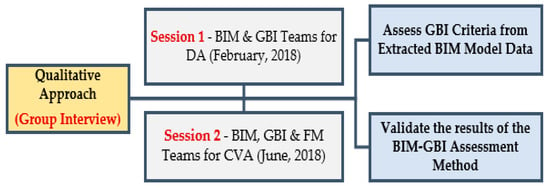
Figure 2.
Research framework.
The group sessions’ primary focus is BIM tools’ ability to assess the GBI criteria from the extracted BIM model data (Table 1). This process helped interviewees to validate the result of the BIM–GBI assessment method.

Table 1.
The Focus Group Session.
3. Discussion of the Results
The BIM tool was developed to examine the feasibility of linking and processing parametric building information related to each GBI subcategory. However, this study aims to develop a BIM–GBI assessment method for the Malaysian construction industry. Results show that BIM must be used for GBI assessment during the DA and CVA stages. A qualitative approach was used to analyse the BIM–GBI assessment method. This method was used to assess each GBI credit using BIM tools, either through authoring or analysis tools with a specific parameter, such as project (BIM direct credit) or new parameters (BIM indirect credit), for both GBI process stages. This method is also used to define the elements of each GBI credit. Table 2 shows the final result of the BIM–GBI assessment method.

Table 2.
BIM-GBI Assessment Method.
BIM tools can be applied directly or indirectly to assess GBI criteria. The direct method involves using authoring and analysis tools to assess each GBI credit from the BIM model. In the indirect approach, some GBI credits require further information, such as documentation, calculation, and testing, to be assessed using the BIM application. Figure 3 shows the BIM tools’ applicability in assessing GBI credits for each of the direct and indirect methods.
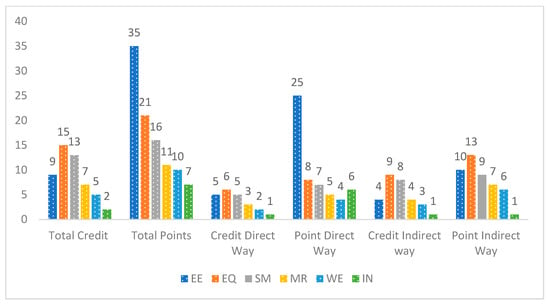
Figure 3.
BIM Application Analysis Method.
The BIM application method can directly assess five credits by using authoring tools to assess two credits. Tools with EE of 25, of the total 35 points, can assess three credits. This means that BIM can assess five credits during DA by using two of the BIM preconstruction uses. The remaining four credits require additional information for the GBI process in the CVA stage using the BIM postconstruction uses. Figure 4 shows the BIM application’s ability to assist the GBI criteria in the design (DA) and operation (CVA) stages in the GBI process.
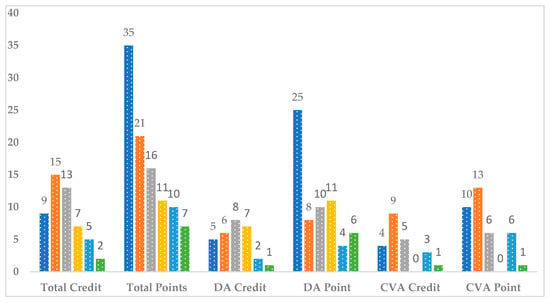
Figure 4.
BIM Application in the GBI Process.
The second criteria in the GBI rating (EQ) are indoor environmental quality with 15 credits of the total 21 points. BIM can directly assess six credits, which can achieve eight points in the design assessment. The remaining nine credits of the total thirteen points can be assessed in CVA using the BIM postconstruction uses. The third GBI criteria are sustainable site management and planning (SM) and are allocated 13 credits of the total 16 points. Five credits can be directly assessed using BIM authoring tools, which can achieve seven points in DA. However, three credits can be assessed by providing information for the model, giving three points during DA. Five credits require additional information using BIM postconstruction use to digitise these credits in the CVA stage. Site utilisation is one of the BIM construction uses and can be applied to assess the materials and resources (MR) criteria in DA. MR has seven credits, but only three credits can be assessed directly using BIM through authoring tools, giving 5 of the 11 points. The remaining four credits with six points can be assessed by providing further information for the design stage model. BIM application can be directly assessed and can give 4 of the total 10 points and 2 credits by using the authoring and analysis tools for WE. The remaining three credits of the total six points can be assessed in the CVA stage using the postconstruction uses of BIM. The last category of the GBI criteria is innovation, and it has two credits of the total seven points. BIM can directly assess one credit in DA, which can give six points. The remaining credit with one point can be assessed by providing documentation in the CVA stage. In general, the BIM application is able to directly or indirectly assess GBI credits for the six GBI categories in different GBI assessment processes. Figure 5 shows the percentages of the capability of BIM to assess BIM credits and points in DA.
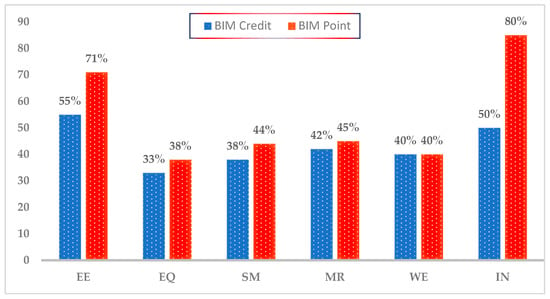
Figure 5.
BIM–GBI Assessment in DA.
The GBI non-residential new construction criteria have 51 credits with a total of 100 points. In contrast, BIM application can achieve 22 credits of GBI criteria, which means that this approach can be digitally and directly assessed using BIM tools. Fourteen of the twenty-two credits can be assessed using authoring tools such as the Revit Autodesk software. Eight credits should be assessed using analysis tools, such as the IES software recommended by GBI. The remaining 29 credits of the GBI criteria can be assessed indirectly by providing additional information, such as documentation, calculation, testing, and adding new BIM tool parameters. BIM application can achieve 26 credits during DA, and 25 credits can be assessed during CVA assessment using BIM uses in different development construction stages. Of the 25 uses of BIM, only 16 are significant for the GBI assessment process. This finding is the basis for the focus group interviews on BIM uses in the preconstruction stage for 20 credits. BIM use for construction has nine credits, and postconstruction uses can achieve 22 credits. BIM can help the design team achieve 55% of points in DA, which is Level 4 GBI certification with the certified rating. The remaining 45 % can be achieved by digital CVA assessment, which is appropriate for comparing GBI assessment with other tools, as shown in Figure 6.
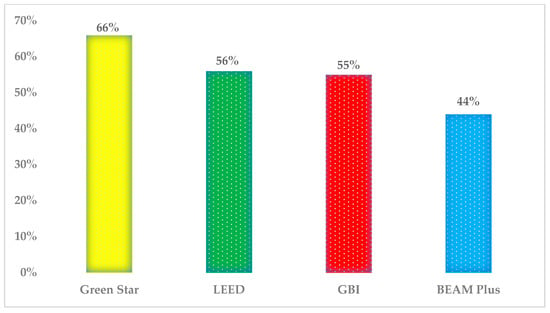
Figure 6.
BIM assessment in the Green Building Tools.
4. Conclusions
The BIM application analysis with GBI assessment certification allowed the professional’s team to analyse each GBI criteria credit with the certification process. This has given an understanding of the potential of using BIM with an interoperable automation approach in the GBI certification process. For the professionals involved in a project, the intended method has defined and assessed each GBI credit by BIM tools associated with a specific parameter in GBI process stages (BIM direct and indirect credit). BIM tools can digitalise and calculate GBI criteria in the early design stages, which allows the design team to produce better designs for sustainability based on the GBI assessment criteria and obtain better achievement during the construction and operation stages. BIM can define the GBI credit, which requires information exchange and additional documentation during the construction and operation stages for digitalisation in each of the 51 GBI credits. The BIM-based-GBI assessment method has provided a new role for the BIM tools, such as Revit functions, to prepare certification and documentation for GBI credits. By applying Revit capabilities along with the fully integrated and interoperable BIM protocol in GBI criteria, all the intended tasks can be achieved, such as 4D constructability, 5D cost estimating, maintenance scheduling, asset management, space management, lighting analysis, site utilisation, and MEP analysis. However, there is a need to verify further the potential of GBI based on a real case study and compare the results produced by the assessment application with the actual GBI submission. Further study is needed to assess how BIM tools and analysis can facilitate the analysis of potential GBI credits. In addition, the application procedures can be standardised and automatically processed by using Revit API functions to set up the corresponding programming. Overall, the BIM–GBI assessment method facilitates the function of BIM tools in the green building assessment and optimises the use of existing resources (i.e., Revit) by saving time preparing a certification submission for GBI in Malaysia.
Author Contributions
Conceptualization, M.S. and A.M.; methodology, M.S.; software, M.S.; validation, L.H.I., M.F.A.K. and A.E.; formal analysis, M.S.; investigation, M.S., L.H.I.; resources, M.S.; data curation, M.S.; writing—original draft preparation, M.S., A.M.; writing—review and editing, M.S., M.A.; visualization, M.A.; supervision, L.H.I.; project administration, M.A., Q.B.a.I.L., Z.A.M., N.I.M.Y.; funding acquisition, Z.A.M. All authors have read and agreed to the published version of the manuscript.
Funding
Prince Sultan University support paying the Article Processing Charges (APC) of this publication.
Institutional Review Board Statement
Not applicable.
Informed Consent Statement
Not applicable.
Data Availability Statement
All data used in this research can be provided upon request.
Acknowledgments
The authors would like to thank Prince Sultan University for their financial support.
Conflicts of Interest
The authors declare no conflict of interest.
Abbreviations
BIM—Building Information Modelling; GBI—Green Building Index; LCA—life cycle assessment; LEED—Leadership in Energy and Environmental Design; BEAM—Building Environmental Assessment Method; EE—Energy Efficiency; SM—Sustainable Site Management and Planning; EQ—Indoor Environmental Quality; WE—Water Efficiency; MR—Materials and Resources; IN—Innovation in Design; DA—Design Assessment; CVA—Completion and Verification Assessment; FM—Facility Management.
References
- Azhar, S. Building Information Modeling (BIM): Trends, Benefits, Risks, and Challenges for the AEC Industry. Leadersh. Manag. Eng. 2011, 11, 241–252. [Google Scholar] [CrossRef]
- Araba, A.M.; Memon, Z.A.; Alhawat, M.; Ali, M.; Milad, A. Estimation at completion in civil engineering projects: Review of regression and soft computing models. Knowl. Based Eng. Sci. 2021, 2, 1–12. [Google Scholar] [CrossRef]
- Eddy, K.; Brad, N. Green BIM: Successful Sustainable Design with Building Information Modeling; Wiley: New York, NY, USA, 2008; pp. 70–71. [Google Scholar]
- Azhar, S.; Khalfan, M.; Maqsood, T. Building Information Modelling (BIM): Now and Beyond. Australas. J. Constr. Econ. Build. 2012, 12, 15–28. [Google Scholar] [CrossRef] [Green Version]
- Bynum, P.; Issa, R.R.A.; Olbina, S. Building Information Modeling in Support of Sustainable Design and Construction. J. Constr. Eng. Manag. 2012, 139, 24–34. [Google Scholar] [CrossRef]
- Stadel, A.; Eboli, J.; Ryberg, A.; Mitchell, J.; Spatari, S. Intelligent Sustainable Design: Integration of Carbon Accounting and Building Information Modeling. J. Prof. Issues Eng. Educ. Pract. 2011, 137, 51–54. [Google Scholar] [CrossRef]
- Guzzetti, F.; Anyabolu, K.L.N.; Biolo, F.; D’Ambrosio, L. BIM for Existing Construction: A Different Logic Scheme and an Alternative Semantic to Enhance the Interoperabilty. Appl. Sci. 2021, 11, 1855. [Google Scholar] [CrossRef]
- Solla, M.; Ismail, L.H.; Md Shaarani, A.S.; Milad, A. Measuring the Feasibility of Using of BIM Application to Facilitate GBI Assessment Process. J. Build. Eng. 2019, 25, 100821. [Google Scholar] [CrossRef]
- Jalaei, F.; Jrade, A. Integrating Building Information Modeling (BIM) and Energy Analysis Tools with Green Building Certification System to Conceptually Design Sustainable Buildings. J. Inf. Technol. Constr. 2014, 19, 494–519. [Google Scholar] [CrossRef]
- Mohamed, R.; Alwan, Z.; McIntyre, L. Factors Motivating the Adoption of BIM-Based Sustainability Analysis. In Proceedings of the International SEEDS Conference 2018, Dublin, Ireland, 6–7 September 2018; LSI Publishing: Dublin, Eire, 2018. [Google Scholar]
- Solla, M.; Milad, A.; Hakim, L.; Shaarani, A.; Yusoff, N.I.M.; Abass, F. The Application of Building Information Modelling in Green Building Index for Energy Efficiency Assessment. In Proceedings of the Second International Sustainability and Resilience Conference: Technology and Innovation in Building Designs, Sakheer, Bahrain, 11–12 November 2020; IEEE: Piscataway, NJ, USA, 2020; Volume 51154, pp. 1–5. [Google Scholar]
- Ilhan, B.; Yaman, H. Green Building Assessment Tool (GBAT) for Integrated BIM-Based Design Decisions. Autom. Constr. 2016, 70, 26–37. [Google Scholar] [CrossRef]
- Ansah, M.K.; Chen, X.; Yang, H.; Lu, L.; Lam, P.T.I. A Review and Outlook for Integrated BIM Application in Green Building Assessment. Sustain. Cities Soc. 2019, 48, 101576. [Google Scholar] [CrossRef]
- Wong, J.K.W.; Zhou, J. Enhancing Environmental Sustainability over Building Life Cycles through Green BIM: A Review. Autom. Constr. 2015, 57, 156–165. [Google Scholar] [CrossRef]
- Gao, H.; Koch, C.; Wu, Y. Building Information Modelling Based Building Energy Modelling: A Review. Appl. Energy 2019, 238, 320–343. [Google Scholar] [CrossRef]
- Motawa, I.; Carter, K. Sustainable BIM-Based Evaluation of Buildings. Procedia-Soc. Behav. Sci. 2013, 74, 419–428. [Google Scholar] [CrossRef] [Green Version]
- Azhar, S.; Brown, J.; Farooqui, R. BIM-Based Sustainability Analysis: An Evaluation of Building Performance Analysis Software. In Proceedings of the 45th ASC Annual Conference, Gainesville, FL, USA, 1–4 April 2009; Volume 1, pp. 1–4. [Google Scholar]
- Lee, S.; Tae, S.; Roh, S.; Kim, T. Green Template for Life Cycle Assessment of Buildings Based on Building Information Modeling: Focus on Embodied Environmental Impact. Sustainability 2015, 7, 16498–16512. [Google Scholar] [CrossRef] [Green Version]
- Maltese, S.; Tagliabue, L.C.; Re Cecconi, F.; Pasini, D.; Manfren, M.; Ciribini, A.L.C.; De Angelis, E. Sustainability Assessment through Green BIM for Environmental, Social and Economic Efficiency. In Proceedings of the International High—Performance Built Environment Conference—A Sustainable Built Environment Conference 2016 Series (SBE16), Sydney, Australia, 17–18 November 2016. [Google Scholar] [CrossRef]
- Lu, Y.; Wu, Z.; Chang, R.; Li, Y. Building Information Modeling (BIM) for Green Buildings: A Critical Review and Future Directions. Autom. Constr. 2017, 83, 134–148. [Google Scholar] [CrossRef]
- Bank, L.C.; McCarthy, M.; Thompson, B.P.; Menassa, C.C. Integrating BIM with System Dynamics as a Decision-Making Framework for Sustainable Design and Operation. In Proceedings of the First International Conference on Sustainable Urbanization (ICSU 2010), Hong Kong, China, 15–17 December 2010. [Google Scholar]
- Golzarpoor, H. Application of BIM In Sustainability Analysis. Ph.D. Thesis, Universiti Teknologi, Skudai, Malaysia, 2010. [Google Scholar]
- Li, Y.; Chen, X.; Wang, X.; Xu, Y.; Chen, P.H. A Review of Studies on Green Building Assessment Methods by Comparative Analysis. Energy Build. 2017, 146, 152–159. [Google Scholar] [CrossRef]
- Suhaida, M.S.; Tan, K.L.; Leong, Y.P. Green Buildings in Malaysia towards Greener Environment: Challenges for Policy Makers. IOP Conference Series. Earth Environ. Sci. 2013, 16, 012121. [Google Scholar]
- Yusoff, W.Z.W.; Wen, W.R. Analysis of the International Sustainable Building Rating Systems (SBRSS) for Sustainable Development with Special Focused on Green Building Index (GBI) Malaysia. J. Environ. Conserv. Res. 2014, 11, 11–26. [Google Scholar] [CrossRef]
- Roh, S.; Tae, S.; Suk, S.J.; Ford, G.; Shin, S. Development of a Building Life Cycle Carbon Emissions Assessment Program (BEGAS 2.0) for Korea’s Green Building Index Certification System. Renew. Sustain. Energy Rev. 2016, 53, 954–965. [Google Scholar] [CrossRef]
- Mun, T.L. The Development of GBI Malaysia (GBI). Renew. Sustain. Energy Rev. 2009, 1–8. [Google Scholar]
- Building, G.; Classification, I. Green Building Index Assessment Criteria For Nrnc Assessment Criteria Overall Points Score Green Building Index Classification Assessment Criteria. Available online: https://www.greenbuildingindex.org/Files/Resources/GBI%20Documents/20090423%20-%20The%20Development%20of%20GBI%20Malaysia.pdf (accessed on 23 April 2009).
- Kamaruzzaman, S.N.; Lou, E.C.W.; Zainon, N.; Mohamed Zaid, N.S.; Wong, P.F. Environmental Assessment Schemes for Non-Domestic Building Refurbishment in the Malaysian Context. Ecol. Indic. 2016, 69, 548–558. [Google Scholar] [CrossRef]
- Lim, Y.; Sediadi, E.; Shahsavari, F.; Azli, N.F.M. Building Information Modelling for Building Energy Efficiency Evaluation. In Proceedings of the 4th Annual International Conference on Architecture and Civil Engineering (ACE 2016), Singapore, 25–26 April 2016; Ace Publisher: New York, NY, USA, 2016; pp. 42–48. [Google Scholar]
- Azhar, S.; Carlton, W.A.; Olsen, D.; Ahmad, I. Building Information Modeling for Sustainable Design and LEED ® Rating Analysis. Autom. Constr. 2011, 20, 217–224. [Google Scholar] [CrossRef]
- Barnes, S.; Castro-Lacouture, D. BIM-Enabled Integrated Optimization Tool for LEED Decisions. Comput. Civ. Eng. 2009, 258–268. [Google Scholar]
- Wong, J.K.-W.; Kuan, K.-L. Implementing ‘BEAM Plus’ for BIM-Based Sustainability Analysis. Autom. Constr. 2014, 44, 163–175. [Google Scholar] [CrossRef]
- Gandhi, S.; Jupp, J. Green BIM and Green Star Certification Practices: Case Studies in Commercial High-Rise Office Design. In Proceedings of the Australian Universities Building Education Association Annual Conference, New Orleans, LA, USA, 17–20 February 2013; pp. 258–268. [Google Scholar]
- Khoshdelnezamiha, G.; Liew, S.C.; Bong, V.N.S.; Ong, D.E.L. BIM-Based Approach for Green Buildings in Malaysia. In Proceedings of the IOP Conference Series: Earth and Environmental Science; IOP Publishing: Bristol, UK, 2019; Volume 268, p. 12052. [Google Scholar]
- Licina, D.; Wargocki, P.; Pyke, C.; Altomonte, S. The future of IEQ in green building certifications. Build. Cities 2021. [Google Scholar] [CrossRef]
- Azis, S.S.A. Improving present-day energy savings among green building sector in Malaysia using benefit transfer approach: Cooling and lighting loads. Renew. Sustain. Energy Rev. 2021, 137, 110570. [Google Scholar] [CrossRef]
- Ascione, F.; De Masi, R.F.; Mastellone, M.; Vanoli, G.P. Building rating systems: A novel review about capabilities, current limits and open issues. Sustain. Cities Soc. 2022, 76, 103498. [Google Scholar] [CrossRef]
- Dilshad, R.M.; Latif, M.I. Focus Group Interview as a Tool for Qualitative Research: An Analysis. Pak. J. Soc. Sci. (PJSS) 2013, 33, 191–198. [Google Scholar]
- Gibbs, A. Focus Groups and Group Interviews. In Research Methods and Methodologies in Education; Sage: Thousand Oaks, CA, USA, 2012; pp. 186–192. [Google Scholar]
- Krueger, R.A.; Casey, M.A. Focus Groups: A Practical Guide for Applied Research; Sage Publications: Thousand Oaks, CA, USA, 2014; ISBN 1483365220. [Google Scholar]
Publisher’s Note: MDPI stays neutral with regard to jurisdictional claims in published maps and institutional affiliations. |
© 2022 by the authors. Licensee MDPI, Basel, Switzerland. This article is an open access article distributed under the terms and conditions of the Creative Commons Attribution (CC BY) license (https://creativecommons.org/licenses/by/4.0/).